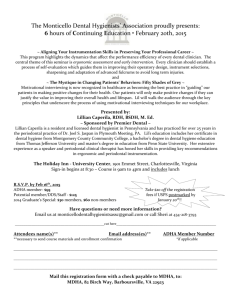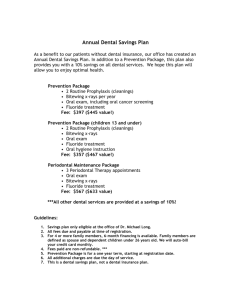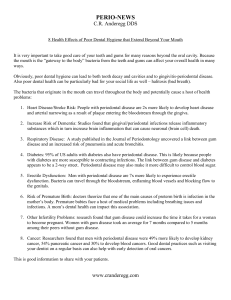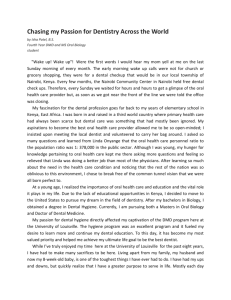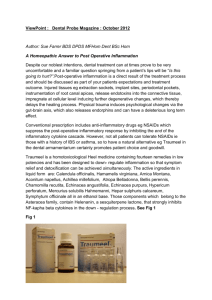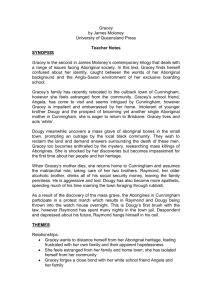Advanced Periodontal Procedures
advertisement
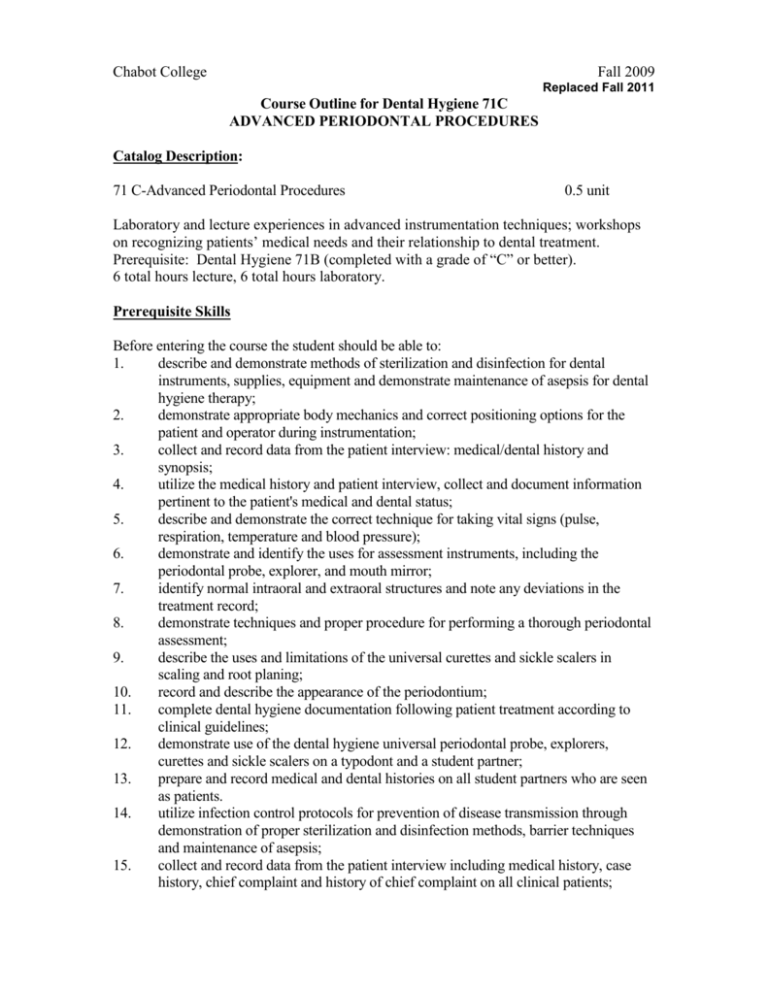
Chabot College Fall 2009 Replaced Fall 2011 Course Outline for Dental Hygiene 71C ADVANCED PERIODONTAL PROCEDURES Catalog Description: 71 C-Advanced Periodontal Procedures 0.5 unit Laboratory and lecture experiences in advanced instrumentation techniques; workshops on recognizing patients’ medical needs and their relationship to dental treatment. Prerequisite: Dental Hygiene 71B (completed with a grade of “C” or better). 6 total hours lecture, 6 total hours laboratory. Prerequisite Skills Before entering the course the student should be able to: 1. describe and demonstrate methods of sterilization and disinfection for dental instruments, supplies, equipment and demonstrate maintenance of asepsis for dental hygiene therapy; 2. demonstrate appropriate body mechanics and correct positioning options for the patient and operator during instrumentation; 3. collect and record data from the patient interview: medical/dental history and synopsis; 4. utilize the medical history and patient interview, collect and document information pertinent to the patient's medical and dental status; 5. describe and demonstrate the correct technique for taking vital signs (pulse, respiration, temperature and blood pressure); 6. demonstrate and identify the uses for assessment instruments, including the periodontal probe, explorer, and mouth mirror; 7. identify normal intraoral and extraoral structures and note any deviations in the treatment record; 8. demonstrate techniques and proper procedure for performing a thorough periodontal assessment; 9. describe the uses and limitations of the universal curettes and sickle scalers in scaling and root planing; 10. record and describe the appearance of the periodontium; 11. complete dental hygiene documentation following patient treatment according to clinical guidelines; 12. demonstrate use of the dental hygiene universal periodontal probe, explorers, curettes and sickle scalers on a typodont and a student partner; 13. prepare and record medical and dental histories on all student partners who are seen as patients. 14. utilize infection control protocols for prevention of disease transmission through demonstration of proper sterilization and disinfection methods, barrier techniques and maintenance of asepsis; 15. collect and record data from the patient interview including medical history, case history, chief complaint and history of chief complaint on all clinical patients; Chabot College Course Outline for Dental Hygiene 71C, Page 2 Fall 2009 Prerequisite Skills-continued: 16. 17. 18. 19. 20. 21. 22. 23. 24. 25. 26. 27. 28. 29. 30. 31. 32. 33. 34. 35. 36. utilize the medical history and patient interview to collect and document information pertinent to the patient's medical and dental status on all clinical patients; obtain a complete medical history and explain the rationale and implications for each portion of the history form; describe and demonstrate the correct technique for taking vital signs (pulse, respiration, temperature, and blood pressure) on all clinical patients; demonstrate assessment skills designed to identify dental needs in order to plan treatment with the goal of delivering comprehensive dental hygiene care on all clinical patients; demonstrate techniques and proper procedure for performing a thorough periodontal assessment and examination of the teeth on all clinical patients; apply principles of instrumentation for the proper use of the explorers, mouth mirror, periodontal probe, scaling/root planing instruments and polishing instruments on all clinical patients; record complete dental restorative charting on a student partner and on all clinical patients; recognize the categories of tooth discolorations and stains; identify the indications and contraindications for selective polishing; perform selective polishing technique with appropriate material selection and precautions for polishing natural and restored tooth surfaces and dental appliances; provide an appropriate rationale for the application of topical fluorides; demonstrate technique, procedures and precautions for applying topical fluoride; apply the principles of instrument sharpening for proper sharpening of curettes and sickle scalers; demonstrate the proper care and treatment of an oral prosthesis; explain and describe the rationale, techniques, and armamentarium involved with scaling and root planing in the treatment of periodontal disease; list the three categories of professional mechanical oral hygiene practices as: a. oral prophylaxis; b. non-surgical periodontal therapy; c. periodontal recall maintenance; list the associated objectives of the three categories of professional mechanical oral hygiene practices; demonstrate the use of the Gracey curet and explorer on a typodont and clinic patient; identify and describe the relationship between universal curette scaler and root morphology in advanced instrumentation; list objectives of Gracey curettes in advanced instrumentation; identify and describe the relationship between the Gracey curette and root morphology in advanced instrumentation; Chabot College Course Outline for Dental Hygiene 71C, Page 3 Fall 2009 Prerequisite Skills-continued: 37. explain how the evaluation of dental hygiene care is accomplished and why it is an essential component of the dental hygiene process; 38. identify the resources available for patients interested in tobacco cessation, provide necessary materials to aid patient. Expected Outcomes for Students Upon completion of the course the student should be able to: 1. Utilize the medical history and patient interview to collect and document information pertinent to the patient’s medical and dental status on all patients 2. Utilize the appropriate clinic form to obtain necessary medical consultation, and or clearances for patients This includes: a. Medical Consultation Form b. Blood Pressure Release Form c. Premedication Form d. Periodontal Co-treatment Form 3. List rationale for use of the Gracey curettes in advanced periodontal instrumentation 4. Identify and describe the relationship between the Gracey curet and root morphology in advanced instrumentation 5. Apply the principles of Gracey instrumentation through demonstration on a typodont 6. Describe the different types of Gracey curettes 7. Apply the principles of instrument sharpening for proper sharpening of Gracey curettes 8. Define Power Scaling 9. Describe the indications, contra-indications and medical precautions when considering power scaling Course Content 1. 2. 3. 4. Record keeping Grace instrumentation Instrument sharpening Power scaling Chabot College Course Outline for Dental Hygiene 71C, Page 4 Fall 2009 Methods of Presentation 1. 2. 3. 4. Lecture Discussion Demonstration and return demonstration Audiovisual Aids Assignments and Methods of Evaluating Student Progress 1. Typical Assignments a. Using a medical history for a clinical patient, determine the need for medical consult prior to treatment b. Demonstrate on a typodont how to instrument the distal surface of a first molar c. Given a cassette of Gracey curettes, demonstrate proper sharpening technique for each instrument 2. Methods of Evaluating Student Progress a. Skills check sheets b. Clinical competency c. Final clinical/didactic exam Textbooks Periodontal Instrumentation, Pattison & Pattison, Pierson, 1992 The standard text for dental hygiene instrumentation. Special Student Materials 1. Instrument kits 2. Protective clothing, eyewear, masks, gloves 3. Typodont

